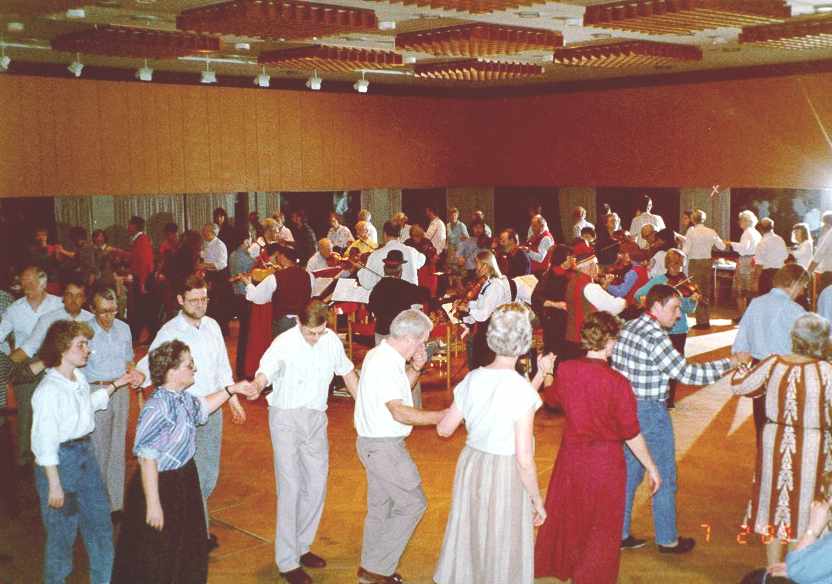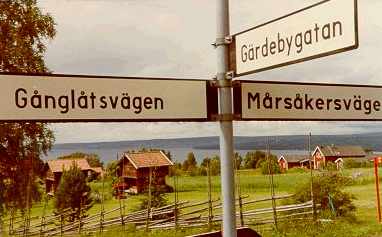
Gärdeby Gånglåt (Gerdeby Walking Tune) |
| Niels Mejlhede Jensen, Bøgeløvsvej 4, 2830 Virum, Denmark. e-mail (web master) |
CONTENTS: (remember: you can use Ctrl Home in usual browsers to get to the top of this page, to the links here)

Photo of this week: Gärdeby gånglåt (= the dance
of this week) is "walked" calmly in a big circle around the musicians in
the middle of the ballroom. We are at the Technical University of Denmark
with "Spillemandsdansen" ("Fiddlers' Dance") playing and dancing every
tuesday night, as open house, now for 20 years. Nobody pays, nobody is
paid. The band has here about 20 musicians, that "came by" this evening,
without previous band rehearsal. I am the leader and fore player here,
the person that nobody seems to observe, as the photo shows. This could
be explained by how well known this gånglåt melody is. We musicians
want to be a part of the dance so we stand in the middle. Very few of the
participants are from the Technical University itself. The photo is taken
by an automatic camera that photographed at time intervals that evening.
20-25 years ago merrily folk dancing came into being again after a period
of decline for one or more generations. Unconventional young people in
Copenhagen and town, with no direct heritage for folk dance, took the lead,
and started to dance and play the old simple music on their own conditions.
A slightly less conventional type of folk dancing suddenly flourished all
over, including the new dance: the gånglåt. The initiative
was ventured even to start this type of folk dancing at the "cold" Technical
University out north of Copenhagen in the middle of the more established
communities. The provocative experiment became a success and soon we were
one of the bigger get togethers of this type. Despite a general decline
in interest at other places the last 10 years, we have had only a moderate
decline in numbers. The age distribution has changed more than 20 years:
from many in their twenties 20 years ago to now many in their sixties.
Our 4 children were at first enthusiastic and loved to walk the gånglåt
at pre-school age, but some years later they feared to be mobbed at school.
Folk dancing is not a trend among the young to day, as it was not in 1960.
This may turn again.
 |
Gärdeby, a lovely Swedish village at the Siljan Lake.
The gånglåt tune from here has been played and "walked" many times a year in Denmark for the last 25 years. The way we walk it in Denmark is now beginning to be tried also some places in Sweden. Gärdeby has named a road after the popular melody. |
Dance of the week, 1999, January 25:
The melody can be heard in midi on computer piano in my tempo (if you
have a sound card). (The melody will loop here until you stop it. In the
table below it will play once). (I have not played the tunes here with
the "drive" I want for dance music).
| 1 | melody | the traditional good dancing melody, polished through generations of use on the fiddle | |
| . | chord
text |
Midi metronome = 80 | simple (folk music) chords, natural for playing the accordion;
these chords are used to make the other parts or voices in triad harmony; there should be no tension from dissonance anywhere including in octavo |
| 2 | A | (Above), parallel part nearest above in third or little more above | |
| 3 | B | (Below), parallel part nearest below in third or little more below | |
| 4 | ns | simple n part; often with the tonic feeling and often with the basic dance rhythm ("motor part"); n is a less constricted part, and tones from the melody are freely included | |
| 5 | C1 | C parts are made from A and B parts, and so they are two parts to the melody | |
| 6 | C2 | C2 is less simple than C1 | |
| 7 | mod =
contra part |
voice up and down (mostly) contra to the melody; it is also made from A and B | |
| 8 | C1 | C1 in octavo | |
| 9 | As | simplified A | |
| 10 | Bs | simplified B | |
| 11 | mels | simplified melody | |
| 12 | blank | . | blank staff for making your own part according to the principles here |
(The midi music is not repeated, except for 1' and 2' voltas).
Use also octavo, up and down.
Where wanted, notes can be changed according to the principles (use
a colour pencil), e.g. to improve the B part with some notes from
A.
The music is aimed at dancing, so part of the orchestra can be the
underlying "motor" when another instrument group is playing its "solo"
part (improvisation) as one of the many repetitions.
The double bass may play its usual notes, because of its low pitch.
It is better to choose a more simple part and play it well.
Because the fast melody for beginners can be of a challenge to play
with good dancing rhythm I have included a simplified melody that can be
played instead.
Accordion: beats per bar: 2+2
(Help coming back from that note
sheet: CLICK note sheet to come back to this page, or just close note
window.
Remember: the note sheet opens in a new separate window, and that may
cover the whole screen. The back button in the tools bar does probably
not work because the window is new, with no history. All you see on the
page are notes because I have placed no link back here for not disturbing
easy submitting to the printer. Close the note window with a click at the
top or with Alt F4, or minimize or reduce the window, or ..., and you are
back to the main page that was there behind all the time).